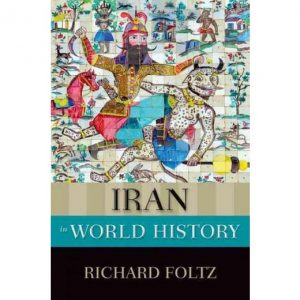|
Reviewed by: Dr. Wyndham Whynot, Department of History and Political Science, Livingstone College Historically, particular countries often played a significant role within their geographical regions; in the Middle East, the 20th-century several countries such as Turkey (Ottoman Empire), Saudi Arabia, Israel, and Iran (Persia) have greatly impacted the region. Since the late 1970s, Iran has increased its prominence in Southwest Asia and is a major player in the politics of the area. Yet, many individuals knowledge of Iran is based on the limited information they receive from news sources that primarily focus on politics, state-sponsored terrorism, and Iran’s attempt to acquire nuclear power. Richard Foltz’s Iran in World History, a part of the New Oxford World History Series, seeks to enlighten individuals about the significant civilizations that existed in Iran and their role in shaping world history. Iran originally referred to as Persia, has a long history of civilizations occupying not only the geographic, borders of modern Iran, but also a greater area of control during earlier Persian Empires, and an impact of Persian culture that spreads well beyond the boundaries of even the greatest civilizations that originated among the Persian peoples Rather than providing a detailed political account of the various Iranian civilizations, the author mixes elements of history, politics, and cultural aspects of Iran’s different Empires and eras. Literature and belief systems are two focal areas in most of the chapters, as Foltz’ provides snippets of Iranian poetry or written works and a discussion of religion’s role in the region. Initially discussing the prehistoric and ancient Iran, Foltz examines the migratory patterns that led to the peopling of the region and early regional civilizations such as the Elamites, Sakas, and Medes. He then discusses the development of Zoroastrianism in the region and how this religion had a significant impact on other monotheistic religions. Foltz next briefly reviews the history of the more familiar “Persian” Empires and lesser one. Besides focusing on accomplished rulers such as Cyrus, Darius, and Ardeshir, he also provides a look at how these empires adopted and adapted cultural elements from other regional ethnic groups. He also notes that Zoroastrianism and Mithraism, originating in Iran, impacted other areas, the former impacting other monotheistic religions, the latter becoming a significant cult in Rome. Remaining chapters of the book focus on Iran’s Islamic era from the early Islamic conquests of Iran to the modern era. Historically, various Iranian scholars helped shape Islamic doctrines, such as Shi’ism. Foltz also examines the impact of Turkic and Mongol invasions on Iran history and the role of Iranians with these invaders. Russia’s and Britain’s impact on 18th through early 20th century Iran is examined, as well as Iran’s influence on European culture. Foltz ends his work focusing on the Pahlavi Dynasty and the shift from a secularizing Iran to a theocratic Iran. Throughout these last chapters, Foltz continues addressing the impact of Iran’s cultural history both in and outside of Iran. Relatively well written and researched, Foltz uses a variety of primary and secondary sources to supplement his text. A chronology of the various Iranian civilizations is located after the last chapter, as well as suggested readings about the different Iranian era. Foltz’ also lists a variety of online resources that are available for researchers interested in the region and its history. Additionally, several maps are dispersed throughout the chapters including those of the Achaemenid and Sasanian Empires; one indicating the boundaries of the Ottoman, Safavid, and Mughal empires; and linguistic maps showing the realm of Iranian based languages. However, the book lacks a political map of the Islamic Republic of Iran and a map of the Parthian Empire, both which would have been useful. Multiple photographs and illustrations related to chapter discussion are appropriately used to emphasize points from the text. Foltz’s book is primarily aimed towards undergraduates and the general public; while the former can benefit from this work; individuals interested in learning about Iran’s history would find this book worth reading. However, individuals looking for an in-depth look at the political history of Iran’s Empires and civilizations would be advised to seek out other works. As a primary textbook for a course this work would be insufficient, yet as a supplemental text, it would be valuable for those taking classes in world history or the Middle East. Furthermore, individuals interested in learning about Iran could use this source to gain a broad and brief understanding of Iran’s historical importance and elements that shape modern Iran’s policies. |


 Iran in World History
Iran in World History 